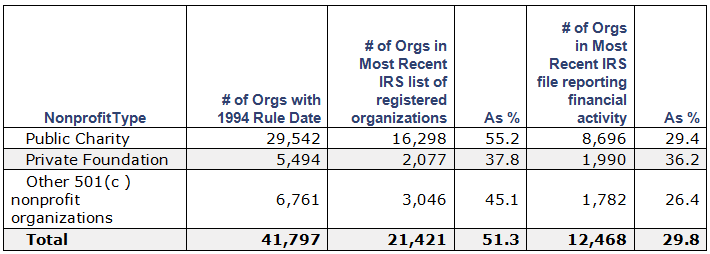Ben Carson said “9 out of 10 nonprofits fail.” Yet data on nonprofits show that half of the organizations that received their tax-exempt status 20 years ago were still considered active by the IRS in 2015.
Carson, who currently ranks second in an average of national polls for the GOP presidential nomination, made the claim during an Oct. 18 interview on ABC’s “This Week.” Host George Stephanopoulos asked Carson, a retired neurosurgeon who has never held public office, to respond to Donald Trump, the current front-runner for the GOP nomination, who questioned if Carson would be able to negotiate with leaders of China, Russia and Iran as president.
Carson touted the success of the Carson Scholars Fund, a nonprofit college scholarship program he founded in 1994, as an example of his ability to negotiate.
Carson, Oct. 18 (2:11 mark): I had to negotiate with many people in different cities as we were putting the Carson Scholars Fund together. It’s now active in all 50 states. As you know, 9 out of 10 nonprofits fail. Not only that, it has won major national awards that are only given to one philanthropic organization in the country out of tens of thousands. That’s not done without having the ability to negotiate.
Carson’s campaign did not respond to our request for supporting documentation. (The Carson Scholars Fund website also doesn’t list any awards that would fit his description of being “only given to one philanthropic organization in the country,” nor could the organization point to other such awards when we called.)
While he did not mention a specific time frame for the claim that “9 out of 10 nonprofits fail,” recent data from the National Center for Charitable Statistics, “the national clearinghouse of data on the nonprofit sector in the United States,” suggest that nonprofit organizations have greater longevity than Carson’s statement would lead viewers to believe.
“Our data do NOT support this claim,” wrote Thomas Pollak, program director for NCCS, a project of the Urban Institute, in an email to FactCheck.org.
Pollak included a table showing that 64 percent of the nonprofit organizations that obtained tax-exempt status from the IRS in 2005 are still considered active in 2015.

In addition, nearly 1 in 4 of the public charities, which make up the majority of all nonprofits and are what Pollak said most people usually mean when they refer to “nonprofits,” reported financial activity in 2015. That is, they filed either an IRS Form 990 or 990-EZ, which require organizations to report their revenues, expenses and assets.
(Small nonprofits, or those with $50,000 or less in gross receipts, only have to file a Form 990-N (e-Postcard), which does not require financial reporting.)
What’s more, over half of the nonprofits that received tax-exempt status in 1994, the same year that Carson and his wife formed the Carson Scholars Fund, are still around.
According to NCCS data provided by Pollak, 51.3 percent of the nonprofits, and 55 percent of the public charities, from 1994 were still considered active in 2015.

Even nonprofits no longer registered with the IRS may not have actually failed.
The NCCS says that it’s difficult to accurately determine deaths of nonprofits from the IRS Business Master File of Exempt Organizations, the source of its data, because of limitations.
NCCS: IRS lists of registered nonprofit organizations and Form 990 filers are a useful starting point for exploring the issue but have significant limitations.
One limitation is that one cannot know what happened to an organization that stops filing with the IRS. It might have died, but it might have successfully merged with another organization, been acquired by one, or transformed into a government agency, church, private foundation, business, or other entity that is not required to file the 990. Alternatively, the organization might have gotten small enough (less than $25,000 in gross receipts) that it was not required to file.
A second limitation is that the 990 is mostly a financial reporting document, so there isn’t going to be any indication of many of the things (like access to legal services and education) that we might hypothesize are related to an organization’s survival chances.
Not knowing what happened to an organization that disappears heightens the problem of equating disappearance with “failure.” Some nonprofits close when they fulfill a mission that they set out to accomplish, so it succeeded rather than failed.
So, do “9 out of 10 nonprofits fail”? We didn’t find evidence of that. The best data we could find from an authoritative source on nonprofits don’t support that claim.